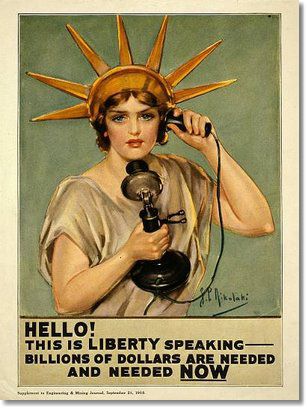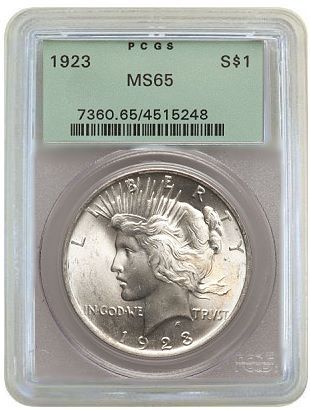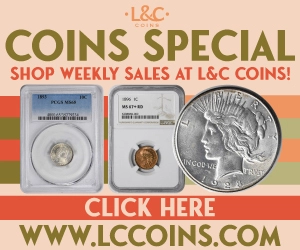By Dan Duncan – Retired, Pinnacle Rarities ……
World War I was called “The War to End All Wars.” The sad irony is that it was arguably the war to begin all wars – at least for the modern era. A couple generations (or more) removed, it’s hard for us to get inside the average man’s head from 1921. But the horrors of that war included the use of nerve gas and mass genocide for the achievement of military goals. The resulting carnage statistics are estimated at over fifteen million civilian and military deaths. With that in mind, it’s easier to understand the sentiment for peace was overwhelming, and from this passion the Peace dollar was born.
Peace
 This story begins with Allied forces pushing back against German occupation. By 1918, the German forces were defeated, and the negotiations of the Allied powers on how best to “punish” Germany began in Paris. These talks originally included seventy delegates from 27 different nations. This soon proved too complex to find any common ground and the actual treaty was drafted by just the three largest nations – The United States, France and Great Britain. Even with just three nations represented, decisions and agreements to key components were tough. Each nation’s goals conflicted with the others.
This story begins with Allied forces pushing back against German occupation. By 1918, the German forces were defeated, and the negotiations of the Allied powers on how best to “punish” Germany began in Paris. These talks originally included seventy delegates from 27 different nations. This soon proved too complex to find any common ground and the actual treaty was drafted by just the three largest nations – The United States, France and Great Britain. Even with just three nations represented, decisions and agreements to key components were tough. Each nation’s goals conflicted with the others.
Ultimately an “unhappy compromise” was reached. It was called the Treaty of Versailles, and it officially ended the war in Europe. But stateside, the battle for a declaration of peace had just begun. Congress initially bucked Woodrow Wilson’s plan and even after the Harding administration took over, Congress on several occasions rejected the League of Nations and the ratification of the Treaty of Versailles. It wasn’t until the summer of 1921 that we passed the Knox-Porter Act, and peace was officially declared between the United States and Germany.
Dollars
The cost of the war was paid in silver from melted silver dollars. As our currency at the time was backed by silver dollars in the treasury vaults, the result of this debt was a recall on circulating silver certificates. Dollar production had been on hiatus since 1904, but the Pittman Act of 1918 ordered over 270,000,000 silver dollars to be coined to relieve this debt and replenish the Treasury’s coffers. The U.S. was going through a recessionary cycle and the Pittman Act went a long way to helping the economy recover. While authorization of the coinage of silver dollars passed in 1918, it wasn’t until three years later that the Peace dollar design was implemented.
Peace Dollars
The idea behind the new dollar design was a commemorative example to serve as a reminder of the atrocities from the war and the value of peace. The path to the enactment of the design was as turbulent as the road to peace itself. The Pittman act had paved the way for new dollars. But, the design ordered was the standard dollar or today’s Morgan type. At the time, monetized commemoratives coins had begun to make waves in numismatic circles and a number of different examples and denominations had been produced since 1892. Up to 1921, all commemoratives had been sold at premiums over face value and only a few ever inadvertently went into circulation. In 1918, as the war was ending, The Numismatist ran an article suggesting a commemorative that would circulate at face value.
 This idea was batted around and in 1920 Farran Zerbe submitted a workable framework to the commemorative idea. Over the following fifteen or so months, the American Numismatic Association enlisted the help of Congressmen William Ashbrook and Albert H. Vestal. Their work along with the blessing of Mint Director Raymond Baker and the Commission on Fine Arts secured a “victory” coin’s place in circulating coinage as the silver dollar. The nation had yet to officially declare peace, but the proponents of the new dollar forged on. Short on time, they held a closed competition amongst the better known medalists and Anthony de Francisci won. His works included the recently released Maine Centennial Coin of 1918. His rushed Peace design met with equal amounts of scorn as delight. And after it underwent some cosmetic alterations, it was pushed through the necessary committees and approved.
This idea was batted around and in 1920 Farran Zerbe submitted a workable framework to the commemorative idea. Over the following fifteen or so months, the American Numismatic Association enlisted the help of Congressmen William Ashbrook and Albert H. Vestal. Their work along with the blessing of Mint Director Raymond Baker and the Commission on Fine Arts secured a “victory” coin’s place in circulating coinage as the silver dollar. The nation had yet to officially declare peace, but the proponents of the new dollar forged on. Short on time, they held a closed competition amongst the better known medalists and Anthony de Francisci won. His works included the recently released Maine Centennial Coin of 1918. His rushed Peace design met with equal amounts of scorn as delight. And after it underwent some cosmetic alterations, it was pushed through the necessary committees and approved.
1921 Morgans were in production for most of the year and were being struck at amazing speed. Upon approval, Baker ceased Morgan production but the Peace designs weren’t struck until the last week in the year. With little preparation time, the dies had not undergone much testing. The bold devices caused the dies to break prematurely and the design elements suffered from lack of sufficient pressure. Initial strikings of the high relief 1921 were not met favorably. The devices weren’t clearly struck up, the lettering wasn’t sharp and the coins were rumored to stack improperly. With die life and production speed compromised by the stylish design, the elements were flattened creating the lowered relief examples used for the duration of the series.
Mintages continued from 1922 to 1927 in large quantities tying up the mint production and causing low mintages of the other denominations of the period. In 1928 mintage numbers decreased, and once the Mint had satisfied the requirements of the Pittman Act, coinage of the Peace dollar was halted. It wasn’t until after the recall of gold coinage that new silver dollars were authorized. The Peace design was reborn with coins struck during 1934 and 1935 to fulfill the requirements of the Silver Purchase Act of 1934.
The design makes a brief encore appearance with the authorization of several million examples in 1964. And, in 1965, Denver coined some 317,000 1964 dated examples. Shortly thereafter, the Coinage Act of 1965 prohibited the production of silver dollars. The idea of a Peace dollar was scuttled with all coins destined for the melting pots. Examples of the 1964-D Peace dollar are rumored to exist, but with recent 1933 $20 legislation, the likelihood of anything ever surfacing is virtually nil.
Today, the Peace dollar is one of numismatics most popular series. The design is rich in history, one that begins as a commemorative coin and ends up an instrument of economic recovery. The story highlights the U.S. involvement in WWI, and its efforts to fund the conflict. The dollar was later used to stabilize the economy during the Great Depression. And now, the series is popular amongst collectors because of its relative affordability, the lack of any true stoppers and mostly for its lasting beauty. The historic past is one that spans three generations and the collectible nature means the Peace dollar will be enjoyed for many more to come.
* * *





Dan– Fascinating article. I love Peace Dollars.